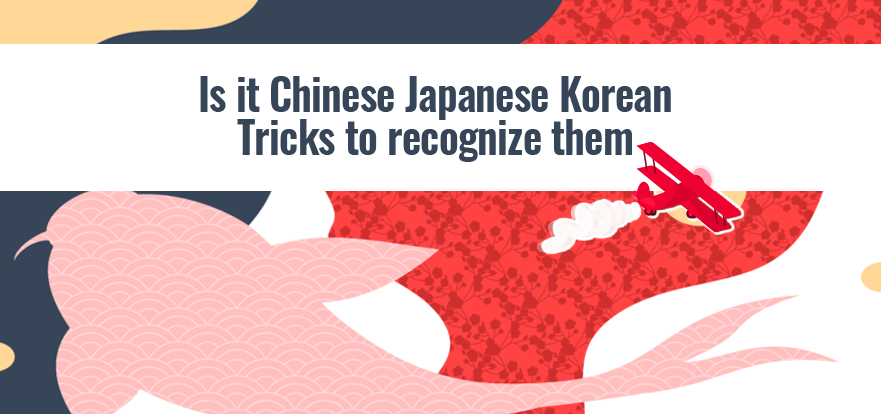🍙Is it Chinese? Japanese? Korean? Tricks to recognize them

For many Spanish speakers, Asian languages can seem completely incomprehensible and indistinguishable from each other. A written text can be intelligible, as they all look like hieroglyphs, and listening to a conversation in the original language is almost a challenge.
ÍNDICE DE CONTENIDOS
Phonetically the three languages are very different and it is quite easy to know if the language they are speaking in Chinese, Japanese, or Korean. But not only do they sound different, but they are also written very differently, here I will explain …
Japanese is considered to have no major difficulty, only 2 or 3 sounds may be more complicated but with a little practice will dominate.
Korean instead is easier to understand but harder to pronounce, has many sounds that neither exist in English.
With regard to the pronunciation of Chinese, it is considered the most complicated, in addition to the sounds that do not exist in Spanish, Chinese has different intonations that, depending on how you say them, completely change the meaning of the word.
When referring to writing
All these languages are based on the Chinese script, however in addition to it, Japanese and Korean have other writing systems.
Japanese is considered to be the most complicated in this regard. It is written without spaces and uses 3 systems to write, so you can imagine it, I have already detailed each of them.
- Hiragana (ひ ら が な), uses many curves, it is a syllabary, the consonant and the vowel go together, it is used to write native Japanese grammar and vocabulary, in addition to the pronunciation of the kanji.
- Katakana (カ タ カ ナ), uses many straight lines, and it is also a syllabary with the same sounds as hiragana, so what distinguishes them? Well, katakana is used to write words from other languages such as foreigners or proper names.
- Kanji (漢字), is the most complex and is the same as Chinese, the Kanji or Chinese letters, it is a logographic system (it expresses ideas, instead of phonemes, most of the time), they represent objects, concepts, actions … they can be combined together to form a large number of words.
An important note, even if the same word can be written with Hiragana or Kanjis it will always be much faster to write and read with Kanjis and will also take up less space. Of course because instead of writing many letters, only one symbol is put. Did I explain myself?
It should be noted that in Japanese, the characters are extremely simple compared to Korean or Chinese, some only require a single stroke of the pencil to reproduce them.
Korean
Many say that Korean is the simplest language to learn to write . This is so because it only has one alphabet, known as Hangeul. However, in Korea, as in Spanish, they use a phonetic alphabet in which each symbol corresponds to a sound. The Hangeul has 19 consonants and 21 vowels that are combined together in syllabic groups . The vowels are divided into vertical, horizontal and compound. Korean letters are written from top to bottom and from left to right. Syllables always begin with a consonant.
Its characters contain a large number of circles and ovals . In it, straight lines also predominate versus curvilinear ones. Also, many people believe that a large part of their symbols resemble faces (similar to the emoticons that are commonly used today).
Note that while Japanese has curved shapes, it doesn’t have full circles like Korean characters.
Chinese
The Chinese language does not have an alphabet . It is made up exclusively of ideograms. Each of these symbols represents an abstract concept, and they combine with each other to form the different words and sentences. In Chinese each word has its own image and each character its own sound. Thus, since it does not have an alphabet, it is necessary to know the meaning of each and every one of these symbols.
Chinese is grouped into 7 language families , also divided into additional dialects. However, the Chinese writing system is relatively consistent throughout the country.
It is important to comment that Chinese writing has two types :
- Traditional, used in Taiwan and southern China, 漢字 (Hanzi)
- Simplified, used in Singapore, Malaysia and the rest of China 汉子 (Hanzi)
The main difference between both writings is that one requires fewer strokes than the other, but both follow the same rule.
I give you an example Coca-Cola in the 3 languages:
Japanese Korean Chinese
コ カ コ ー ラ 코카 – 콜라 可口可樂
Kokakōra koka kolla Kěkǒukělè
Details to take into account
- The Koreans put spaces between words, as well as European languages. On the other hand, neither Chinese nor Japanese separate words with spaces.
- The Japanese have their own punctuation, the Korean uses the same signs that European languages. Chinese calligraphy sometimes uses a question mark or exclamation point.
Let’s talk about the direction of writing, in Japanese it is allowed to write horizontally like we Westerners and you can still do it vertically . You must take into account that if the text is horizontal we must read it starting at the top and on the left. On the other hand, if it is vertical, it has to start at the top right.
Grammar of the 3 languages
- The Korean language shares the same basic grammar with Japanese and more than half of it uses vocabulary from Chinese, so they can get you confused at some point as they are very similar.
- In Chinese and Japanese there are no articles . The Japanese do not differentiate between “a” and “some” either. Although this does not cause many problems for Spaniards who want to learn Japanese, it can be difficult for Japanese who want to learn Spanish.
- In Chinese it is not necessary to indicate the masculine or feminine gender , as well as the plural. Chinese words are therefore invariable.
- The Chinese language is of the SVO type, that is, the sentences are composed by subject – verb – object, like most Western languages. If there is time and place, the simple phrase will acquire this structure, STLVO, that is, subject – time – place – verb – object.
- Chinese has the simplest grammar and Japanese has so many commonly used English terms that it is not very difficult to memorize the words. In contrast, Korean grammar is probably the most difficult.
- Korean and Japanese have a SOV structure, (different from Chinese) that establishes subject-object-verb, and the conjugation of verbs varies according to the person the speaker is addressing (through three different levels of respect , this aspect is the same as the Japanese one).
- The Korean has no gender , numerical agreement or articles (such as French or German).
- Speaking of the formality or the different levels of respect, it is noted with the changes in certain nouns and in the verbal endings.
- The Koreans often use pronouns shared or community , like us or we, instead of I or me. This stems from the communal nature of Korean culture and society.
- The nouns, both in Korean, Chinese and Japanese do not have a gender or number , which can make them very easy to use, but complicated when interpreting.
- Speaking of grammar in Chinese , compared to Spanish or English it is simpler and easier since it is very reduced, although in Japanese it is much more complicated and comprehensive. Likewise, Chinese does not conjugate verbs and adjectives, while in Japanese it does.
In summary
In summary, we can say that Korean is considered the simplest language to learn to read and write . Chinese requires more effort to memorize and learn to write, however, believe it or not, there is a logic behind those characters, to learn to read them without having to memorize each one. As a curious note, note that although it shares the same basic grammar with Japanese, 50% of its vocabulary comes from Chinese.
Until a next article,
다음 기사 까지
次 の 記事 ま で
直到 下 一篇 文章



